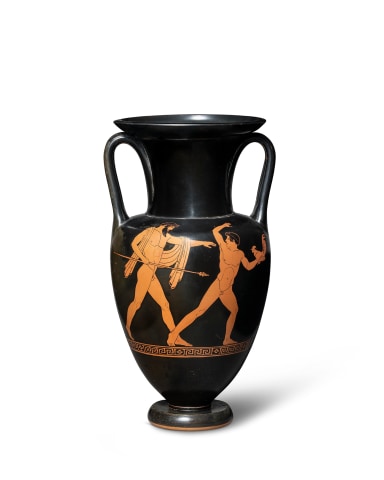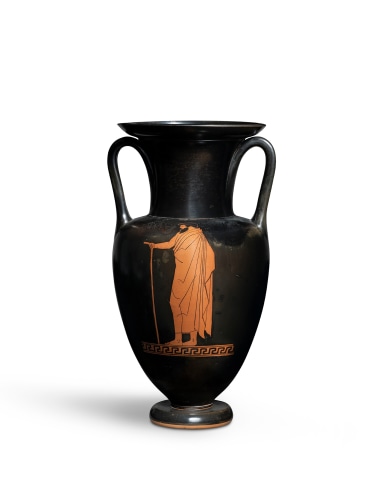Greek red-figure Nolan amphora of Zeus and Ganymede, Athens, c.455-450 BC, attributed to the Achilles Painter (Oakley)
Terracotta
Height: 31.2cm
11483
Charles Ede, London
Elegant neck amphora of Nolan form, decorated in red figure showing the pursuit of Ganymede by Zeus. The nude youth runs to the right, his left arm holding up a...
Elegant neck amphora of Nolan form, decorated in red figure showing the pursuit of Ganymede by Zeus. The nude youth runs to the right, his left arm holding up a finely detailed cockerel, his other raised above his head as he turns back to gaze at his pursuer, a thin fillet in added red encircles his head and is tied in a bow at the front. The bearded Zeus is also nude save for a swath of drapery slung over his right shoulder, around his back and draped over his left forearm, and a laurel wreath in added red around his head. He reaches a hand forward to touch the handsome mortal boy Ganymede, and in his right hand he holds a spear horizontally towards the youth. Their bodies show tension in the muscles which have been highlighted with lines of a lighter slip. Beneath them is a meander. Side B shows a draped male figure with pointed beard and walking staff, a fillet in added red around his head, a band of greek key beneath him. The resting surface and underside are reserved, the rest of the body in an attractive black glaze. Intact, scattered losses of the glaze across the surface touched in, a couple of chips to the underside of the rim made good, some slight misfiring on one side beneath the handle.
Oakley described the Achilles Painter as "the classical painter par excellence, and the most important and influential vase painter of his time". His ability to use such fine lines and simple, balanced compositions create a sense of serenity in his decoration that has forever been admired. His hand was first named by Beazley in 1914 after a vase in the Vatican which has a solitary figure of Achilles on the obverse. At the same time he attributed 41 red-figure and 47 white-ground vases to him. By the time Oakley wrote his grand monograph on the Achilles Painter there were some 307 vases attributed to the artist. School of thought have differed over time, but he is thought to be a pupil of the Providence Painter, of Hermonax and most commonly of the Berlin Painter.
The current example is among the best quality and best preserved of those vases attributed to the Achilles Painter.
Oakley described the Achilles Painter as "the classical painter par excellence, and the most important and influential vase painter of his time". His ability to use such fine lines and simple, balanced compositions create a sense of serenity in his decoration that has forever been admired. His hand was first named by Beazley in 1914 after a vase in the Vatican which has a solitary figure of Achilles on the obverse. At the same time he attributed 41 red-figure and 47 white-ground vases to him. By the time Oakley wrote his grand monograph on the Achilles Painter there were some 307 vases attributed to the artist. School of thought have differed over time, but he is thought to be a pupil of the Providence Painter, of Hermonax and most commonly of the Berlin Painter.
The current example is among the best quality and best preserved of those vases attributed to the Achilles Painter.
Provenance
Jerry Eisenberg, Royal Athena, New York, USA; acquired from Christie's 1999Mr. Leonard Lussier, USA; acquired from the above, 2001
Terry Hughes, London, UK; acquired 2001
Exhibitions
Princeton University, 2001-2003, on loan from Mr Lawrence W. Lussier (L.2001.42)Literature
For side B compare Beazley archive number 213858Publications
NFA Classical Auctions, New York, Egyptian, Near Eastern, Greek & Roman Antiquities, 11th December 1991, lot 86John Oakley, The Achilles Painter (1997), p.119-120, no.39, pl.21, pl.48d
Christie's, New York, Antiquities, 9th December 1999, lot 302; listed under 'Various Properties'
Jerome Eisenberg, Art of the Ancient World XII, January 2001, no..211
Beazley archive number 19887



